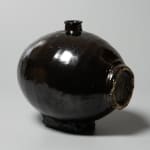Takesue Hiomi 武末日臣
H23.4 × W17 × D20 cm
Further images
-
(View a larger image of thumbnail 1
)

-
(View a larger image of thumbnail 2
)

-
(View a larger image of thumbnail 3
)

-
(View a larger image of thumbnail 4
)

-
(View a larger image of thumbnail 5
)

-
(View a larger image of thumbnail 6
)

-
(View a larger image of thumbnail 7
)

-
(View a larger image of thumbnail 8
)

-
(View a larger image of thumbnail 9
)

-
(View a larger image of thumbnail 10
)

-
(View a larger image of thumbnail 11
)

-
(View a larger image of thumbnail 12
)

-
(View a larger image of thumbnail 13
)

-
(View a larger image of thumbnail 14
)

-
(View a larger image of thumbnail 15
)

-
(View a larger image of thumbnail 16
)

-
(View a larger image of thumbnail 17
)

Nagasaki born potter, Takesue Hiomi’s works are full of history and grace. He is known for producing works using pottery clay from Tsushima, where most pottery styles draw influence from the Korean Peninsula, as it is said that clay from Tsushima rivals the clay from South Korea. He has garnered many fans due to his research and reproduction of old pottery styles of the Joseon Dynasty. As a venerated artist who is considered a master of Korean ceramics in Japan, Takesue’s pottery is well respected in Korea and Japan, and perhaps lesser known in the west. He began researching Korean style kilns and surveying them in 1989, and since then he has mastered black glazes, Kohiki, Mishima, and Karatsu. His work is full of intelligence, and his works embody sensitive forms carefully balanced between the wabi sabi aesthetics of Japan, and the Korean influences of the Joseon dynasty. His works express soulful history, and speak to the heart of Japanese pottery tradition. He is most well known for his Kohiki, Mishima, and Black glazed wares.
This type of black glazed ceramic are often seen as a marker of the category of “antique” in Contemporary Japanese pottery, particularly “Richo”, or Korean-style pottery from the 17th century, which was a period of time that saw the Japanese invasion of Korea during the Tokugawa Shogunate. Historical and archaeological evidence shows that there was output beyond tea ware, despite one key conflict in history being known as the “Tea bowl wars”- the Battle of Imjin.
During this time, daily vessels for use (known in Japanese as “Utsuwa”) were not collected and preserved in the same way as fine art objects were. Therefore, most of what we see today of these ceramics are found in archaeological sites. Thus, our knowledge of Korean ceramic industries during this time can be found in museums, where they are preserved with dignity and care. That said, such daily wares from Korea, such as Satsuma ware and Mishima ware, became ubiquitous in the Japanese domestic market. Now, Japan has many master potters who revive old Korean styles in major ceramic traditions founded by Korean immigrant potters brought over by the Tokugawa Shogun, who was famous for his passion for the arts. Stylistic traces can be seen in contemporary work that hark back to this history.
Contemporary potters in Japan who research Korean ceramics know this history by heart, and potters such as Takesue spend hours in museums studying their forms. One such ware from this material cultural history that was imported to Japan during the 17th century was the beautiful, dark, murky black iron-glazed pottery.
Artist CV
1955 Born in Kamitsushima, Nagasaki Prefecture
1989 Traveled to Korea to research Goryeo Dynasty ceramics Conducted excavation surveys of old kiln sites such as Ido and Mishima Since then, visits Korea every year for research
1990 Became a Shinto priest of Okunitama Shrine in Taishukunijima
1994 Built a kiln in Oura, Tsushima
2008 Held at GALLERY Ichibankan and GALERIE AZUR after moving the kiln to Toyoyama Ide, Tsushima
2022 Ginza Kurodatouen Solo exhibition
















